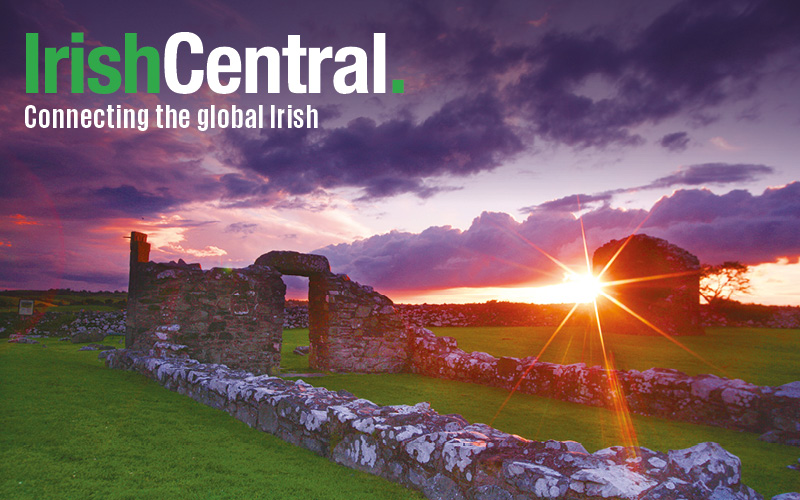“It is my wish to photograph people of all nationalities, who have made the decision to move from Ireland for economic reasons[:] in and around the city, juxtaposed with landscapes that are significant to their pasts. If that sounds like you or if you know of somebody who is about to move, please bring my proposal to their attention.
“I want to make these works monumental, to show those depicted in a true heroic spirit. For after all, they are making a huge jump into the void of uncertainty and this needs to be commemorated – perhaps like never before…”
So began David Monahan's “Leaving Dublin” project: with a blog post, one year ago. The 47-year-old photographer has lived in Dublin his whole life and has seen friends and family members depart from the city throughout the years. Some have returned, but many have not.
Still more are leaving now – part of the dramatic surge in post-boom emigration that began in 2009. The statistics, as we know, are staggering. A January report by the Dublin-based Economic and Social Research Institute estimated that 100,000 people – more than two percent of the country's population – will leave Ireland between April 2010 and April 2012. That averages to about 1,000 people a week.
From the mass exodus of The Great Hunger to the significant population losses of the 1950s and 80s, Ireland is no stranger to emigration. But that doesn't make what is happening now any easier. The vast majority of those who are leaving are young, highly skilled and educated, but can't find work. They see an Ireland lacking in stability and opportunity and, in the eyes of some, lacking a social, political and financial consciousness. In addition to needing work, many are fed-up with the way the banks and politicians let the nation down, and are looking to broaden their horizons elsewhere. There's a sense of dismay that emigration is on the steady rise again, since many thought that it had become a thing of Ireland's past. At the same time, there's a feeling of pride and purpose; of having made a difficult but necessary choice; of setting out for someplace new. While the figures plainly convey the volume of the current wave of departures, they cannot do much in terms of capturing this complicated spirit.
This is where Monahan comes in. A year ago, one of the photographer’s friends and her boyfriend were leaving Ireland for Australia. “He'd been out of work for a year and a half, she'd been out of work for about nine months,” Monahan recounted in a recent interview with Irish America. “They weren't doing too well here,” he continued, “so they decided to go to the Australian embassy and quick as you like they had tickets booked and they were ready to go. I thought it would be nice to take a photograph of her before she left town, in a place that meant something to her.”
His friend turned out to be too shy to pose, but the thought remained in Monahan's head. “I had a good sense of what needed to be done and how it would look…it was too good of an idea, too important of a project to let it lie.”
So he didn't. He set up a mock shoot and posted the resulting photograph online, along with his initial call for participants.
Since then, he's done 30 shoots with individuals and families who have left Dublin. The result is a body of work that triumphs at communicating both gravity and strength, resignation and purpose, wistfulness and hope. All of the photographs adhere to what has become Monahan's signature style for the series: dark, painstakingly lit images of soon-to-be emigrants, always with a slightly battered antique suitcase nearby.
Interested subjects contact Monahan with two or three possible locations, which he visits to examine the visual and technical possibilities. Once a site has been chosen, Monahan and his rotating crew of five assistants head out to meet the poser and begin the shoot, all of which take place at night. On a practical level, this helps ensure that they don't draw too much attention from passersby and that there aren't any disturbances. Artistically, this allows Monahan to create the distinctive lighting and mood consistent throughout all of the images. With his Hasselblad H3D 50 camera, the photographer takes a few frames of his subject, and then does additional background shots of the location. All of this is accomplished using only one light source, which Monahan explains gives him “the possibility of almost painting with it. You can place it here, you can place it there, and you can light things you like and let things you don't particularly want to light go dark if you wish. It gives you the chance to fine-tune the shot.” Back in his studio, he then pieces the different elements of the scene together in Photoshop until he has one final composite image, which he posts on his blog along with a brief story about the person the photo depicts and the journey he or she is about to embark on.
Even a cursory glance at the series shows that Monahan has stuck to his initial aim of making the photographs “monumental;” of showing “those depicted in a true heroic spirit.” The compassion in Monahan’s artistic vision is palpable. Though the images are dark and shadowy, they cannot be described as meek or melancholy. The subjects sit proudly and contemplatively in their chosen locations, usually perched on a suitcase Monahan uses as a recurring prop in every frame.
The exact age of the suitcase is something of a mystery, but Monahan does know that it was last stamped at the Tilbury Docks in England in 1961. Much more than a mere prop, the suitcase is a tangible artifact and a visual cue connecting Ireland's previous periods of emigration with its current one.
Indeed, for Monahan, the suitcase cuts to the emotional core of this project, since it was last used by one of his many family members who have moved to England. He is quick to add that he's “not trying to be sentimental by using it;” rather, that its purpose is to “make a little statement that it is part of the past and [that] this cycle has happened over and over and over again. The unfortunate thing, the sadness for me, is that I believed that particular cycle had finished, as did a lot of people. But very, very quickly it [began again] and people have been leaving at a heavy pace ever since. It's quite saddening that that phenomenon has re-occurred, but it's also nice to know and acknowledge, by the inclusion of the suitcase, that this has occurred before. And I suppose what we're striving for is to create a situation where it doesn't happen again.”
Though he readily admits it was not his initial intention, within the larger scheme of the project the places in the photographs have become almost as prominent and important as the people. The locations vary greatly. They've been to “the hills on the outskirts of Dublin, looking back on the lights of the city; the sea ports; in the city center, right in the middle; and in suburbia.”
In this sense, the photos are not just portraits of the young emigrants, but also of contemporary Ireland. This is an element of the project that evolved over time. “Once you start talking to people and they make the choice of a place to sit, you start getting the impression that you're moving from place to place, that you're covering the entire city from pillar to post, really.
“Initially, no, it wouldn't have been a predominant thought of mine. I really just wanted to put people somewhere that was relevant to them and looked somewhat striking. But as time progresses it's definitely becoming a portrait of the city, a portrait of a city and those it has chosen to do without.” They are pictures of a city and those who no longer inhabit it.
The subjects of Monahan’s photographs are in other cities now. Some have made permanent moves, others are away on year-long visas, still others have actually returned home from Ireland – reversing the influx of immigration Ireland experienced during the good years of the Celtic Tiger. As people continue to leave and word of Monahan’s project spreads, he plans to continue his work of capturing people in a quiet moment before their departure. In tandem with the expanding range of people leaving the country, the demographic of his subjects is widening, too, and he hopes to further that by working with more families and more people in their 40s and 50s. Though it will be difficult, Monahan plans on stopping the shoots when he reaches 70 images, at which point he will look for a gallery space to exhibit the series – not in Ireland, but abroad, where the people the photographs depict have traveled. When asked why, Monahan replies,“I think it needs to be in those locations first and foremost, to bare witness to those who have left.”
Four of the people Monahan has photographed discuss their experiences of and reasons for emigrating. The e-mail interviews have been edited for length and clarity.
Ryan Cronin-Neilan
Originally from: Cabinteely, Dublin
Why did you leave Ireland? I’m a recent college graduate and as such I qualified for a 12 month internship visa. With things the way they are in Ireland right now, really, I would have been stupid to stay.
Where are you now? Right now I’m living in Philadelphia, which I love, I must say.
What are you doing? I’m currently looking for an internship, hopefully with a newspaper as I’d love to work for a newspaper when I return home.
Did having to leave come as a shock or was emigration always a possibility for you? I think emigration is always a possibility for the Irish. It’s what we do. We’re a tiny country and no strangers to recession. Of, say, a core group of 20 friends or so I have at home, I think about 7 or 8 are still in Ireland. The rest are in Australia, Chile, Vietnam etc. Anywhere to get work.
Will you go back to Ireland? I’ll be going back because my visa is only for a year. Whether there will be anything for me to go back to is a different story though.
Connor McMahon
Originally from: Dublin, through and through.
Why did you leave Ireland? I lived in Dublin for forty years and will always love the city and its people – it’s my home, for better or worse. That said, I feel it is not actually Dublin I have left but more so Ireland, at least in the Celtic Tiger sense of it. Before all of that, I can remember a relative material contentment, and a much greater sense of neighborhood – both locally and internationally. To me, these things represent two of our biggest losses these last few years. And cynically I choose to believe that these two same things are never to return.
Where are you now? I am in south London, right on the edge of the city. Here, at least, I am close to the countryside, which makes it a little easier. I miss that most about Dublin: how quickly you can get out and up to Howth, or for a long windy stroll on Portmarnock beach. I don’t like London much, but I find it does have its compensations.
What are you doing? I was fortunate enough to have had the option to move from a contract-based role in Dublin, where I worked as a designer for a multinational firm, to a very similar – albeit permanent – role within the same organization at their offices in Surrey. Also, I pursue my career as an artist and musician, and London, of course, is as full of potential in that regard as any other city of its size and vibrancy in the world.
Did having to leave come as a shock or was emigration always a possibility for you? Admittedly there were other more personal circumstances that motivated my decision, but I had always felt it an option, regardless. As I said, I love my city and my country, but I could never shake the feeling, even from an early age, that those with whom we entrust great civic responsibility in Ireland ultimately prove themselves incapable and inept, and therefore sooner or later likely to fail catastrophically.
Will you go back to Ireland? I'll come back permanently if I'm seeing significant progress on the civil front. By this I actually mean a less neo-liberal and more socially engaged political regime who will – among other things – evidence to the Irish nation a greater concern for its people rather than its banking classes. I do remind myself however, that in fact I am only four hours away door-to-door via Gatwick. And so, with some planning, I'm over as often as is feasible, in the meantime.
Aoife McMonagle
Originally from: Celbridge, Co Kildare.
Why did you leave Ireland? I had been thinking about moving to another country for quite a while, and with my fixed-term contract coming to an end and prospects not looking so good at home, the timing just seemed right. My primary motivation wasn’t really to escape the economic situation, though it is probably a big part of the reason that I plan to stay away for perhaps longer than I originally thought.
Where are you now? I’m living in Toronto, Canada.
What are you doing? I’m working in marketing communications for an IT company, so I am working in my field.
Did having to leave come as a shock or was emigration always a possibility for you? As above, it was always something I had been thinking about, though at the time I didn’t classify it as “emigration” per se, more an opportunity to travel and work. Obviously the situation in Ireland does not seem to be improving, so I do plan to stay here for the foreseeable future.
Will you go back to Ireland? Obviously Ireland is still home to me, but I don't see myself going back for the next few years at least. After that it's hard to say, the longer you're away the less likely it is that you'll go back I suppose, but in my mind I still see myself going back someday.
Aoife O’Donnell
Originally from: Cork, raised in Kildare
Why did you leave Ireland? I graduated from the Dublin Institute of Technology in June 2010 and found it near to impossible to find steady work. I was looking for any job – not just one related to photography, which is what I studied in college. I spent several months on social welfare until my friend said she was moving to New York City on a graduate visa. I did some research and found I was eligible to live and work in the United States for up to 12 months. Essentially, the reason I moved to New York was for personal adventure and to further my career, which was quite stagnant in Ireland.
Where are you now? I am located in Brooklyn, New York. It’s an incredibly vibrant place to live; a sort of sanctuary for anyone in the arts, as you are close to Williamsburg and Lower Manhattan. The energy here is quite palpable, which I find refreshing and inspiring as a photographer.
What are you doing? I currently work as a teaching assistant in the International Center of Photography.
Did having to leave come as a shock or was emigration always a possibility for you? I always felt that emigration was a possiblity for me, from quite a young age. The Irish have, of course, been emigrating to Australia and the United States for years. Thankfully, I am emigrating more out of choice rather than being forced. I have always had a passion for traveling, instilled in me by my parents, whose unconventional trips abroad broadened my world-view from a young age. It has come as a major shock to hear recently that 1,000 people per week are emigrating from Ireland. It leaves me with a sense of guilt, somewhat, that I am one of the many skilled graduates/workers leaving our island in a sort of mass exodus.
Will you go back to Ireland? It really all depends on my success in the States. There are certain opportunities to progress in my career in New York that I know I will never encounter in Ireland. But, on the other hand, my roots lie in Ireland and my heart will always remain there. It may be a case that I might not have a choice to stay in America longer than what my visa stipulates, so I must remain aware of that reality. However, if it did come to that I plan to do a world trip, which could see me settling somewhere entirely unexpected. I would like to think that I (and the thousands of other emigrants) will return to Ireland someday and that the knowledge I have absorbed from my travels will help me to contribute in some way, shape or form, to helping restore the vibrancy and progress of our beloved nation.
For more information, visit Monahan’s blog: thelillipution.blogspot.com




Comments